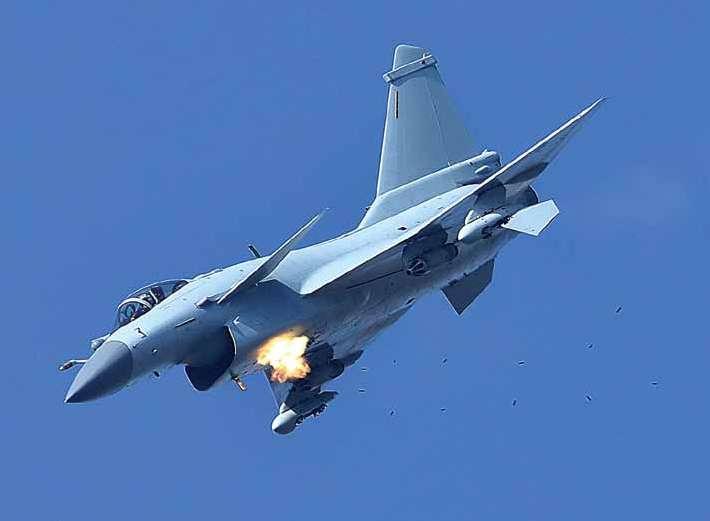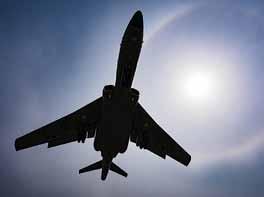
5 minute read
China Intrusion
achinese J-10 fighter Jet attached to an aviation brigade under the Plaair force
FREQUENT VIOLATION OF TAIWANESE AIRSPACE BY CHINA
By Air MArshAl B.K. PAndey (retd)
As per a statement issued by the Ministry of Defence, Taiwan, on April 12 this year, as many as 25 military aircraft of the People’s Republic of China (PRC) intruded into the Air Defence Identification Zone (ADIZ) of the air space under the control of Taiwan. As per reports emanating from the Ministry of Defence of Taiwan, the fleet of intruding aircraft of the PRC included 18 combat jets consisting of 14 J-16 and four J-10, four H-6K bomber aircraft that were capable of carrying nuclear weapons, two anti-submarine warfare aircraft and one Airborne Early Warning and Control System (AWACS) aircraft.
A FREQUENT OCCURRENCE
Violation of Taiwanese airspace by military aircraft of the PRC appears to have become a regular feature as it has been occurring frequently. Instances of incursion by aircraft of the China into the airspace of Taiwan has increased significantly, particularly so over the last two years. This latest incursion on April 12 this year into the ADIZ of the air space under the control of Taiwan, has been by the largest fleet of military aircraft in the last 12 months. However, what is noteworthy as well as more significant is that it came even as the United States of America (USA) had issued a warning against an increasingly aggressive China. Just prior to this incursion by a fleet of 25 military aircraft, on February 19 this year, nine combat jets of the People’s Liberation Army Air Force (PLAAF) of the PRC had violated the airspace over Taiwan in the Southern region as the Chinese aircraft intruded into the airspace over Pratas which is an island controlled by Taipei. Pratas island which is a part of Taiwan, lies in the Northern part of the South China Sea and is the largest amongst the islands in the area. In response to the incursion by the aircraft of the PLAAF, Taiwan put both ground based air defence systems and air defence aircraft of its Air Force on high alert. Taiwan also issued a warning by radio to the pilots of the intruding aircraft of the PRC to vacate the airspace of Taiwan without any delay. Prior to this episode, on January 24 this year, there was another such case of airspace violation in which 12 aircraft of the PLAAF had intruded into the airspace over Taiwan.
RELATIONS BETWEEN CHINA AND TAIWAN
Taiwan which is also known as the Republic of China (ROC), has been an independent nation since 1949 and has its own democratically elected government. However, China has a differing perception on the status of the island nation and still regards Taiwan as a part of its territory. PRC firmly believes in and has been propagating its “One China Policy” and claims that Taiwan is an inalienable part of PRC. Although, economic ties between Taiwan and China have been thriving especially so in the recent years, differing political perceptions between the two nations especially under the new leadership on both sides, have had an adverse impact on the political equation between the two nations. What must have aggravated the hostile approach that China has had towards Taiwan is the latter’s drive to establish formal diplomatic relations with major powers and international organisations in an effort to remain outside the influence and control of the Communist mainland. So far, Taiwan has been able to establish diplomatic relations with as many as 15 nations.
ROLE OF THE USA
In recent years, the USA has displayed a notable pro-Taiwan approach and in the period 2007 to 2018, it has sold more than $25 billion worth of military equipment including advanced weapon systems to this island nation which constituted 75 per cent of its total arms import. Taiwan ranked as the ninth largest recipient of arms globally. In order to further strengthen its defences against the PRC, Taiwan has indicated plans to substantially enhance its defence expenditure which, in all likelihood, will be invested in the procurement of advanced weapons systems that would include missiles, electronic warfare technology and missile defence systems. This would certainly have irked China and would have served to aggravate political tensions between the two nations. Apart from the military support that the USA has displayed towards Taiwan, political developments in the USA especially after Donald Trump took over as the President, only served to further aggravate levels of tension and conflict between the USA and China. This in turn had an adverse effect on the political and military relations between the PRC and Taiwan.
POSSIBILITY OF MILITARY CONFLICT
Despite the economic ties with Taiwan, China has always maintained a hostile military posture towards the tiny neighbour. China continues to strengthen its military capability against Taiwan by deploying missiles along the Taiwan Strait and periodically conducting military exercises in the vicinity of the island nation. As part of this objective and effort, the armed forces of China continue to develop and deploy advanced military capabilities in the event of a situation in which there may arise the need to undertake a military campaign against Taiwan. China aims to remain prepared at all times to use military power to resolve any dispute with Taiwan or any other nation over the issue of the status of the island nation. Beijing has refused to renounce the use of force to resolve disputes over the island’s status. The increasing frequency of transgression by military aircraft of China into the airspace of Taiwan, is a clear indication of China’s plans to employ air power to deal with Taiwan in the future. SP











